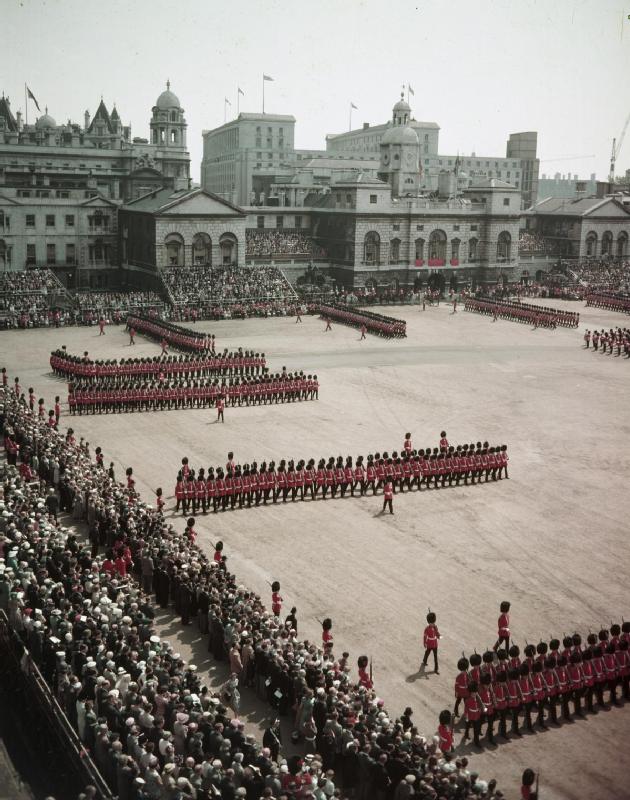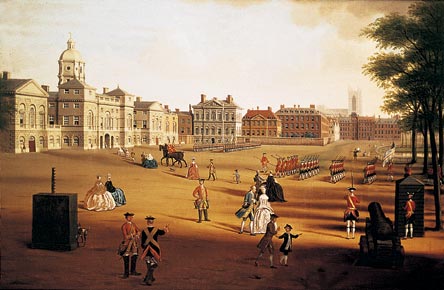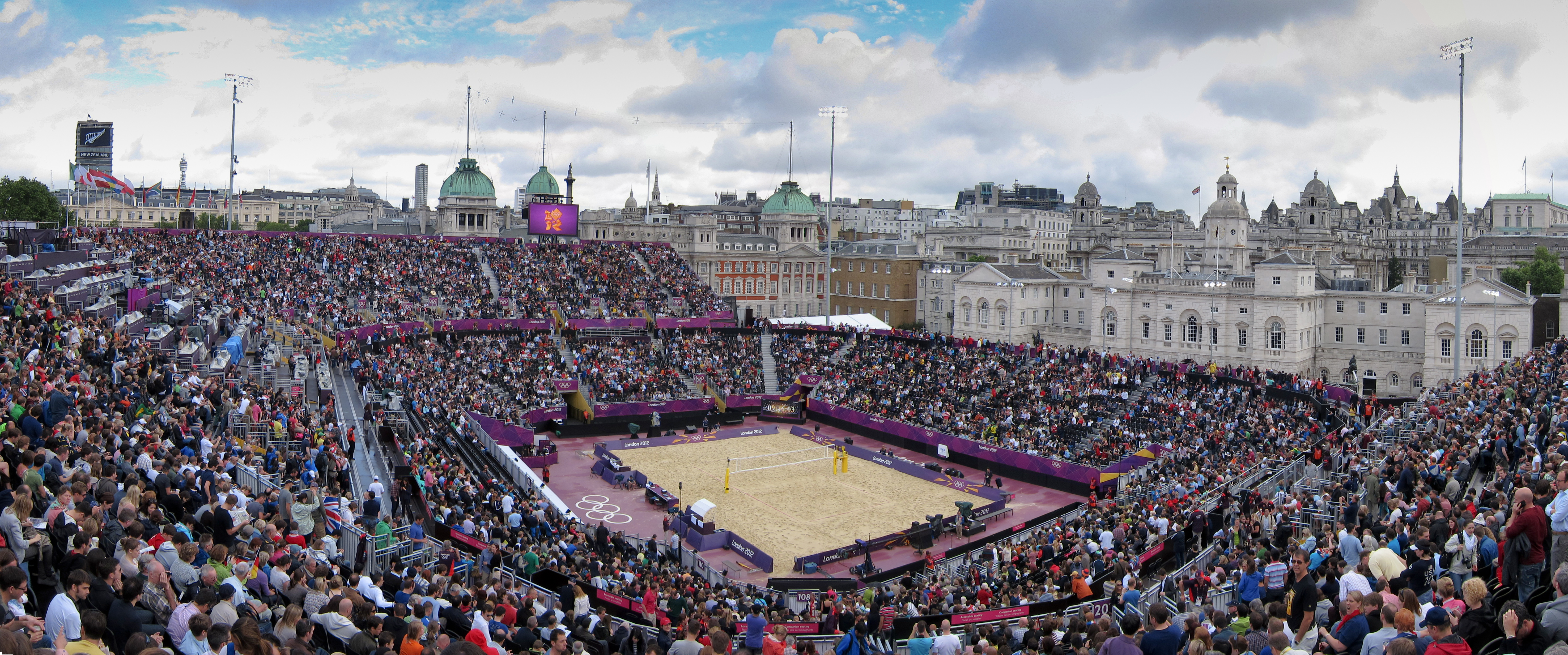Horse Guards Parade on:
[Wikipedia]
[Google]
[Amazon]
 Horse Guards Parade is a large
Horse Guards Parade is a large
 Horse Guards Parade was formerly the site of the
Horse Guards Parade was formerly the site of the
 For much of the late 20th century, Horse Guards Parade was used as a car park for senior
For much of the late 20th century, Horse Guards Parade was used as a car park for senior
 A number of military monuments and trophies ring the outside of the parade ground, including:
* To the west, beside St James's Park, the Guards Memorial, designed by the sculptor
A number of military monuments and trophies ring the outside of the parade ground, including:
* To the west, beside St James's Park, the Guards Memorial, designed by the sculptor
 Horse Guards Parade hosted
Horse Guards Parade hosted
 Horse Guards Parade is a large
Horse Guards Parade is a large parade ground
A parade is a procession of people, usually organized along a street, often in costume, and often accompanied by marching bands, floats, or sometimes large balloons. Parades are held for a wide range of reasons, but are usually celebrations of s ...
off Whitehall
Whitehall is a road and area in the City of Westminster, Central London. The road forms the first part of the A3212 road from Trafalgar Square to Chelsea. It is the main thoroughfare running south from Trafalgar Square towards Parliament Sq ...
in central London
Central London is the innermost part of London, in England, spanning several boroughs. Over time, a number of definitions have been used to define the scope of Central London for statistics, urban planning and local government. Its characteris ...
(at grid reference ). It is the site of the annual ceremonies of Trooping the Colour, which commemorates the monarch's official birthday, and the Beating Retreat
Beating Retreat is a military ceremony dating to 17th-century England and was first used to recall nearby patrolling units to their castle.
History
Originally it was known as watch setting and was initiated at sunset by the firing of a single ...
.
History
 Horse Guards Parade was formerly the site of the
Horse Guards Parade was formerly the site of the Palace of Whitehall
The Palace of Whitehall (also spelt White Hall) at Westminster was the main residence of the English monarchs from 1530 until 1698, when most of its structures, except notably Inigo Jones's Banqueting House of 1622, were destroyed by fire. ...
's tiltyard, where tournament
A tournament is a competition involving at least three competitors, all participating in a sport or game. More specifically, the term may be used in either of two overlapping senses:
# One or more competitions held at a single venue and concentr ...
s (including jousting
Jousting is a martial game or hastilude between two horse riders wielding lances with blunted tips, often as part of a tournament. The primary aim was to replicate a clash of heavy cavalry, with each participant trying to strike the opponen ...
) were held in the time of Henry VIII
Henry VIII (28 June 149128 January 1547) was King of England from 22 April 1509 until his death in 1547. Henry is best known for his six marriages, and for his efforts to have his first marriage (to Catherine of Aragon) annulled. His disa ...
. It was also the scene of annual celebrations of the birthday of Queen Elizabeth I
Elizabeth I (7 September 153324 March 1603) was Queen of England and Ireland from 17 November 1558 until her death in 1603. Elizabeth was the last of the five House of Tudor monarchs and is sometimes referred to as the "Virgin Queen".
Eli ...
. The area has been used for a variety of reviews, parades and other ceremonies since the 17th century.
The adjacent Horse Guards building was once the Headquarters of the British Army. The Duke of Wellington was based in Horse Guards when he was Commander-in-Chief of the British Army. The current General Officer Commanding London District still occupies the same office and uses the same desk. Wellington also had living quarters within the building, which today are used as offices.
Car park usage
 For much of the late 20th century, Horse Guards Parade was used as a car park for senior
For much of the late 20th century, Horse Guards Parade was used as a car park for senior civil servant
The civil service is a collective term for a sector of government composed mainly of career civil servants hired on professional merit rather than appointed or elected, whose institutional tenure typically survives transitions of political leaders ...
s; about 500 were granted the privilege, which was known as the 'Great Perk'. The PIRA's mortar attack on 10 Downing Street on 7 February 1991, which was carried out from a vehicle parked in Horse Guards Avenue nearby, narrowly missed causing casualties and led to concerns. In April 1993 the Royal Parks Review Group, headed by Dame Jennifer Jenkins (later Baroness Jenkins) recommended that the parade should be restored for public use, and linked to St James's Park by closing Horse Guards Road. The proposal was taken up by the Department of National Heritage but then resisted by senior Cabinet members, apparently under pressure from the civil servants who were to lose their parking places.
Public revelation of the resistance led to considerable criticism by Simon Jenkins
Sir Simon David Jenkins (born 10 June 1943) is a British author, a newspaper columnist and editor. He was editor of the ''Evening Standard'' from 1976 to 1978 and of ''The Times'' from 1990 to 1992.
Jenkins chaired the National Trust from 20 ...
, a newspaper columnist, who pressured Sir Robin Butler
Frederick Edward Robin Butler, Baron Butler of Brockwell, (born 3 January 1938) is a retired British civil servant, now sitting in the House of Lords as a crossbencher.
Early life and family
Butler was born in Lytham St Annes, Lancashire, on ...
, Head of the Home Civil Service, to end general usage as parking as part of a wider programme of reforms. In late 1996 Horse Guards Parade was cleared, for repairs, and in March 1997 it was announced that parking was banned.
Layout
The parade ground is open on the west side, where it faces Horse Guards Road and St James's Park. It is enclosed to the north by the Admiralty Citadel and the Admiralty Extension building, to the east by Admiralty House,William Kent
William Kent (c. 1685 – 12 April 1748) was an English architect, landscape architect, painter and furniture designer of the early 18th century. He began his career as a painter, and became Principal Painter in Ordinary or court painter, bu ...
's Horse Guards (formerly the headquarters of the British Army
The British Army is the principal land warfare force of the United Kingdom, a part of the British Armed Forces along with the Royal Navy and the Royal Air Force. , the British Army comprises 79,380 regular full-time personnel, 4,090 Gurkha ...
) and the rear of Dover House (home of the Scotland Office
The Office of the Secretary of State for Scotland ( gd, Oifis Rùnaire Stàite na h-Alba), often referred to as, and formerly officially called, the Scotland Office, is a department of His Majesty's Government headed by the Secretary of State ...
), and to the south by Kent's Treasury building (now used by the Cabinet Office
The Cabinet Office is a department of His Majesty's Government responsible for supporting the prime minister and Cabinet. It is composed of various units that support Cabinet committees and which co-ordinate the delivery of government object ...
), garden walls of 10 Downing Street
10 Downing Street in London, also known colloquially in the United Kingdom as Number 10, is the official residence and executive office of the first lord of the treasury, usually, by convention, the prime minister of the United Kingdom. Along w ...
(the official residence and office of the British Prime Minister) and Mountbatten Green before the Foreign and Commonwealth Office's west wing. Access to the south side is restricted for national security.
On the east side, Horse Guards Parade is normally accessible to the public from Whitehall through the arches of Horse Guards.
Monuments
 A number of military monuments and trophies ring the outside of the parade ground, including:
* To the west, beside St James's Park, the Guards Memorial, designed by the sculptor
A number of military monuments and trophies ring the outside of the parade ground, including:
* To the west, beside St James's Park, the Guards Memorial, designed by the sculptor Gilbert Ledward
Gilbert Ledward (23 January 1888 – 21 June 1960), was an English sculptor.
He won the British Prix de Rome for sculpture in 1913, and in World War I served in the Royal Garrison Artillery and later as a war artist. He was professor of ...
in 1923–26 and erected to commemorate the First Battle of Ypres
The First Battle of Ypres (french: Première Bataille des Flandres; german: Erste Flandernschlacht – was a battle of the First World War, fought on the Western Front around Ypres, in West Flanders, Belgium. The battle was part of the Firs ...
and other battles of World War I.
* To the north, the Royal Naval Division War Memorial
The Royal Naval Division Memorial is a First World War memorial located on Horse Guards Parade in central London, and dedicated to members of the 63rd (Royal Naval) Division (RND) killed in that conflict. Sir Edwin Lutyens designed the memorial ...
, designed by Sir Edwin Lutyens
Sir Edwin Landseer Lutyens ( ; 29 March 1869 – 1 January 1944) was an English architect known for imaginatively adapting traditional architectural styles to the requirements of his era. He designed many English country houses, war memor ...
in 1925, removed before the Second World War, and returned to its original site beside the Admiralty Extension building and rededicated on "Beaucourt Day" (13 November 2003).
* To the east:
** Equestrian statues of Field Marshals Roberts and Wolseley (see Equestrian statue of the Earl Roberts, London and Equestrian statue of the Viscount Wolseley).
** A Turkish cannon made in 1524 "by Murad son of Abdullah, chief gunner" which was captured in Egypt in 1801.
** The Cádiz Memorial, a French mortar mounted on a brass monster which commemorates the lifting of the siege of Cádiz
Cádiz (, , ) is a city and port in southwestern Spain. It is the capital of the Province of Cádiz, one of eight that make up the autonomous community of Andalusia.
Cádiz, one of the oldest continuously inhabited cities in Western Europe, ...
in Spain in 1812.
* To the south, statues of Field Marshal Kitchener and of Admiral of the Fleet Mountbatten (see Statue of the Earl Kitchener, London and Statue of the Earl Mountbatten, London).
An oddity is the black background to the number 2 of the double sided clock which overlooks the Parade Ground and the front entrance, it is popularly thought to commemorate the time the last absolute monarch of England, Charles I Charles I may refer to:
Kings and emperors
* Charlemagne (742–814), numbered Charles I in the lists of Holy Roman Emperors and French kings
* Charles I of Anjou (1226–1285), also king of Albania, Jerusalem, Naples and Sicily
* Charles I of ...
, was beheaded at the Banqueting House opposite.
Sporting and public events
2012 Summer Olympics
 Horse Guards Parade hosted
Horse Guards Parade hosted beach volleyball
Beach volleyball is a team sport played by two teams of two or more players on a sand court divided by a net. Similar to indoor volleyball, the objective of the game is to send the ball over the net and to ground it on the opponent's side of th ...
at the 2012 Summer Olympics
The 2012 Summer Olympics (officially the Games of the XXX Olympiad and also known as London 2012) was an international multi-sport event held from 27 July to 12 August 2012 in London, England, United Kingdom. The first event, th ...
held in London. Temporary courts and seating designed by Populous were installed by the Arena Group, much as seating is installed annually for Trooping the Colour. There was one court with a capacity of 15,000 with two tiers and a floodlight tower at each of its four corners, two practice courts to the east of the arena, and a further six practice courts at St. James's Park. Most matches were played on Centre Court, but some matches were played on Court 1 on day 6 of the competition.
London Polo Championships
Horse Guards Parade hosted the 1st London Polo Championships on 17 and 18 June 2009 with teams from around the world.Sainsburys Anniversary Games 2014
On Sunday 20 July 2014, a temporary arena played host to the anniversary games.References
External links
* {{Coord, 51.5047, -0.1283, type:landmark_region:GB-WSM, display=title 17th-century establishments in England Event venues established in the 17th century Squares in the City of Westminster Parks and open spaces in the City of Westminster Sports venues in London Equestrian venues Venues of the 2012 Summer Olympics Olympic volleyball venues Parade grounds